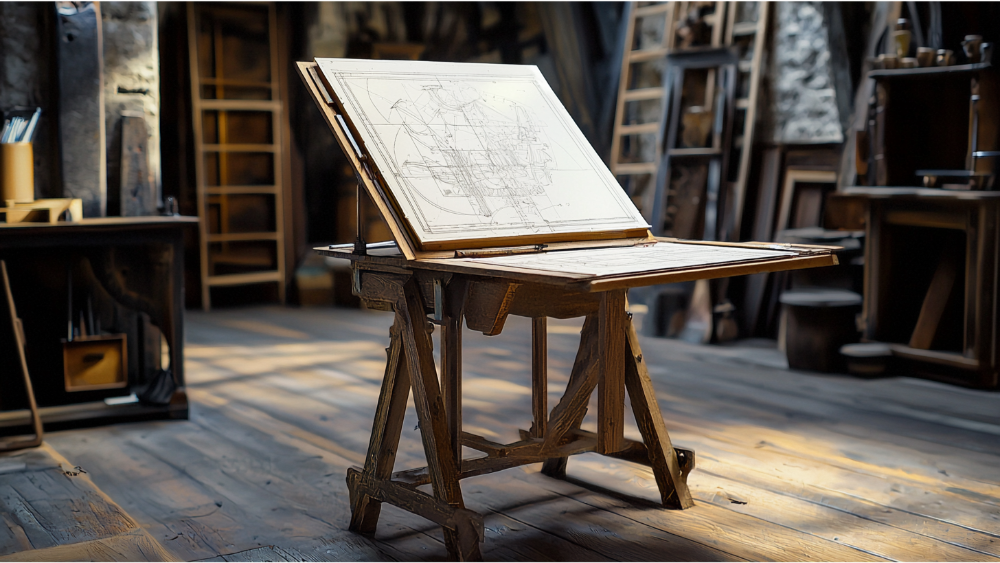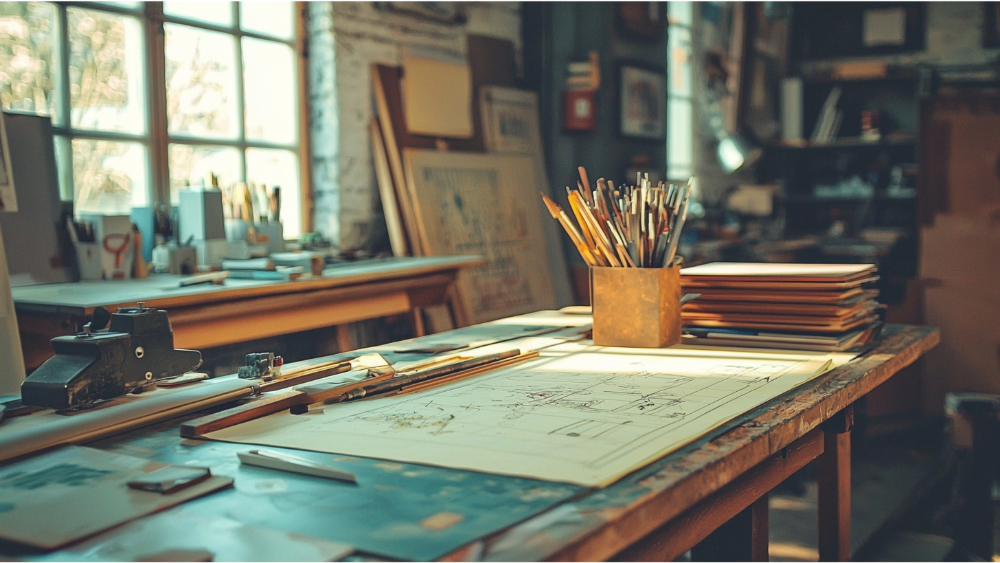
What is a Drafting Table? What is it Used For?
A drafting table is a specialized piece of furniture that is designed for use by architects, engineers, and artists. It provides a flat surface with an adjustable angle that allows for precision drawing and drafting. Drafting tables are commonly used in design studios, architectural firms, and art schools. These tables often come with additional features such as storage drawers and built-in lights to enhance the drawing experience.
History of Drafting Tables
The history of drafting tables dates back to the 14th century when they were known as "tilting desks." These early versions were essentially a flat surface mounted on a frame with legs that could be adjusted to different angles.
However, it wasn't until the 18th century that more advanced drafting tables were developed with features such as rulers and protractors for precise measurements.
What is a Drafting Table Used For?

Drafting tables are primarily used for technical drawing and drafting, such as creating architectural blueprints, engineering designs, and detailed artwork. They provide a stable and adjustable surface that allows for precise measurements and angles to be drawn with accuracy. Drafting tables are also commonly used for calligraphy, mapmaking, and other forms of detailed hand-drawing.
How Does a Drafting Table Work?
Drafting tables typically have two main components: a flat surface and an adjustable angle mechanism. The flat surface is usually made of wood or laminate and can be tilted to various angles using the angle mechanism, which often consists of hinges, levers, or knobs. This allows for the user to adjust the table to their preferred working position.
Features of a Drafting Table
Modern drafting tables come in a variety of styles and sizes, but they all share some basic features. These include:
- A large, flat surface for drawing or drafting
- An adjustable angle for different drawing positions
- A parallel bar or ruler to keep drawings straight and precise
- Storage drawers or shelves for organizing drawing tools and supplies
- Storage for sliding keyboard shelf
- A sturdy construction that can support heavy materials without wobbling or tipping over
Some drafting tables also have additional features such as built-in lighting, adjustable height options, and ergonomic designs for added comfort during long hours of use.
Types of Drafting Tables

There are several types of drafting tables available on the market, each with its own unique features and benefits. Some of the most common types include:
Fixed-angle drafting tables
These are classic drafting tables featuring a fixed angle that cannot be altered, typically set at a comfortable incline for drawing or drafting. Generally, these tables are more affordable than other types, making them a popular choice for students and hobbyists.
However, they lack the versatility of adjustable-angle tables, which allow users to customize the incline for various tasks and preferences. While fixed drafting tables provide stability and simplicity, they may not accommodate all creative needs, especially for professionals seeking flexibility in their work.
Adjustable-angle drafting tables
As the name suggests, these adjustable angle tables feature a versatile design that allows artists to customize their drawing positions for maximum comfort and creativity. With a range of angles to choose from, artists can easily shift between sitting and standing, or adjust the surface to suit intricate details or broad strokes.
These tables are ideal for artists working on various projects, whether it’s sketching, painting, or drafting, providing the flexibility and support needed to enhance their artistic process.
Split-top drafting tables
These innovative tables feature a unique split top surface design, where one section is perfectly flat and the other is angled. This versatile configuration allows users to simultaneously engage in drawing and writing, catering to the diverse needs of architects, engineers, and artists. The flat surface is ideal for sketching detailed plans or documents, while the angled section provides an ergonomic position for drafting or note-taking. As a result, these tables have become immensely popular in creative and technical fields, enhancing productivity and fostering collaboration among professionals.
Vintage Drafting Table Designs
Vintage drafting tables have become popular collector's items due to their unique designs and nostalgic appeal. Some of the most sought-after vintage drafting table designs include:
- Angle-iron drafting tables: These feature a sturdy metal frame with an adjustable angle mechanism, often found in schools and studios.
- Cast iron base drafting tables: These heavy-duty desks boast a solid cast iron base for stability and durability, with a wooden or metal surface for drawing.
- Adjustable height drafting tables: Popular in the mid-century modern era, these tables had adjustable height options, making them versatile for various tasks.
Drawing Board
While not technically a drafting table, drawing boards serve a similar purpose and are often used interchangeably. They consist of a flat surface mounted on an easel or stand, allowing for adjustments to the angle and height. Drawing boards are popular among artists who prefer to work in a more traditional and portable manner.
Light Table
Light tables, also known as light boxes, are specialized drafting tools that feature a backlit surface for tracing and transferring designs onto a new sheet of paper. They are commonly used in industries such as animation, fashion design, and architectural planning.
Small Standing Desk
With the rise of remote work and digital art, small standing desks have become a popular choice for creative professionals. These compact drafting tables often feature adjustable height options and ergonomic designs, providing a comfortable and versatile workspace for artists.
Benefits of Using a Drafting Table

Using a drafting table has several benefits, including:
- Increased precision: The adjustable angle and additional features such as parallel rulers help artists and designers create precise drawings with straight lines.
- Improved ergonomics: Many modern drafting tables are designed with ergonomics in mind, reducing strain on the neck, back, and wrists during long hours of use.
- Organization: The storage drawers and shelves on drafting tables allow for easy organization of drawing tools and art supplies, making them readily accessible while working.
Drafting Table vs Drawing Table
While the terms "drafting table" and "drawing table" are often used interchangeably, there is a slight difference between the two. A drafting table is specifically designed for technical drawing and precision work, while a drawing table is more general and can be used for various forms of art or creative projects. Drawing tables may lack some table accessories found on drafting tables, such as parallel rulers and adjustable angles.
Tilted Surface vs Flat Surface
One of the main distinguishing factors between drafting tables is their surface type – tilted or flat. Tilted surfaces are typically found on traditional drafting tables and are ideal for precise technical drawings. On the other hand, a flat surface is more suitable for artists who work in different mediums and may require a larger area for working. Ultimately, the decision between a tilted or flat surface comes down to personal preference and the type of work being done.
What are Drafting Tables made from?
Drafting tables can be constructed from various materials, with wood and metal being the most prevalent. Wooden drafting tables are celebrated for their timeless and classic appearance, while metal tables provide a contemporary look and enhanced durability. Some designs even incorporate both materials, combining a maple hard wood frame with metal legs or the other way around.
Frequently Asked What is a Drafting Table Questions

Can drafting tables be used for other purposes besides drafting?
Yes, drafting tables can also be used for calligraphy, mapmaking, and any other form of detailed hand-drawing.
Do all drafting tables have adjustable angles?
No, some traditional drafting tables have a fixed angle that cannot be adjusted. However, most modern drafting tables come with adjustable surfaces.
Are there portable options for drafting tables?
Yes, there are various foldable and collapsible options available on the market for those who need to transport their drawing table frequently. These are ideal for students or professionals who work remotely or travel often.
Can drafting tables accommodate different sizes of paper?
Yes, most drafting tables come in standard sizes that can accommodate a range of paper sizes. However, some may have adjustable features such as extending arms or slide-out trays to fit larger sheets of paper.
How much do drafting tables cost?
The price of drafting tables can vary depending on the type, size, and features. Basic fixed-angle tables can range from $50 to $200, while high-end adjustable-angle or split-top tables may cost up to $500 or more. It's important to consider your specific needs and budget when selecting a drafting table.
How do I pick the right drafting table?
When selecting a drafting table, consider factors such as your budget, the type of work you will be doing, and the features that are important to you. It's also helpful to read reviews and compare different options before making a decision. Ultimately, choose a drafting table that fits your specific needs and enhances your creative process choosing the perfect drafting table.
Conclusion

Drafting tables have stood the test of time and remain an essential tool for artists, designers, and architects alike. With their versatile designs and adjustable features, they provide a comfortable and organized workspace to enhance creativity and productivity. Whether you prefer a traditional or modern style drafting table, there are various options available to suit your needs.
Consider the type of work you will be doing and choose a drafting table that will support your artistic process. So go ahead, take your work to new heights with a quality drafting table!




